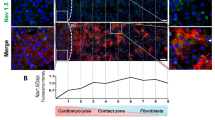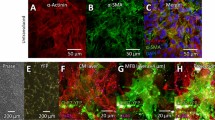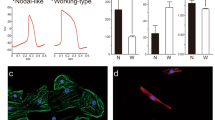Abstract
In an earlier study exploring the potential of gene transfer to repair myocardial conduction defects, we observed that myotubes, generated by forced expression of MyoD, exhibit reduced excitability when also modified to express connexin43 (Cx43). We hypothesized that this effect was caused by gap junction-mediated coupling between myotubes and the underlying fibroblast feeder layer. This intriguing possibility has important implications for ongoing efforts to develop strategies for repairing myocardial conduction defects by gene transfer, and also provides novel insights into the electrophysiological function of naturally occurring heterologous cell coupling within the heart. Although a conductive function for fibroblasts through heterologous coupling has previously been reported, the current study provides novel evidence that fibroblasts can modulate cardiomyocyte excitability in a Cx43-dependent manner. In a co-culture study system, neonatal rat cardiomyocytes were grown on monolayers of mouse fibroblasts with genetically altered Cx43 expression and the effect on intrinsic beat frequency examined. Cardiomyocytes grown on wild-type (WT) fibroblasts expressing native levels of Cx43 beat significantly slower than cells grown on fibroblasts devoid of this molecule (germline knockout) or with dominant-negative functional suppression. Expression of Cx43 in fibroblasts from Cx43 knockout mice restored cardiomyocyte beat frequency, to rates comparable with those observed in co-culture with WT fibroblasts.
This is a preview of subscription content, access via your institution
Access options
Subscribe to this journal
Receive 12 print issues and online access
$259.00 per year
only $21.58 per issue
Buy this article
- Purchase on Springer Link
- Instant access to full article PDF
Prices may be subject to local taxes which are calculated during checkout




Similar content being viewed by others
References
Donahue JK, Kikuchi K, Sasano T . Gene therapy for cardiac arrhythmias. Trends Cardiovasc Med 2005; 15: 219–224.
Kizana E, Ginn SL, Allen DG, Ross DL, Alexander IE . Fibroblasts can be genetically modified to produce excitable cells capable of electrical coupling. Circulation 2005; 111: 394–398.
Kleber AG, Rudy Y . Basic mechanisms of cardiac impulse propagation and associated arrhythmias. Physiol Rev 2004; 84: 431–488.
Nag AC . Study of non-muscle cells of the adult mammalian heart: a fine structural analysis and distribution. Cytobios 1980; 28: 41–61.
Manabe I, Shindo T, Nagai R . Gene expression in fibroblasts and fibrosis: involvement in cardiac hypertrophy. Circ Res 2002; 91: 1103–1113.
Kohl P . Heterogeneous cell coupling in the heart: an electrophysiological role for fibroblasts. Circ Res 2003; 93: 381–383.
Rudy Y . Conductive bridges in cardiac tissue: a beneficial role or an arrhythmogenic substrate? Circ Res 2004; 94: 709–711.
Goshima K . Formation of nexuses and electronic transmission between myocardial and FL cells in monolayer culture. Exp Cell Res 1970; 63: 124–130.
Gaudesius G, Miragoli M, Thomas SP, Rohr S . Coupling of cardiac electrical activity over extended distances by fibroblasts of cardiac origin. Circ Res 2003; 93: 421–428.
Boyett MR, Dobrzynski H, Lancaster MK, Jones SA, Honjo H, Kodama I . Sophisticated architecture is required for the sinoatrial node to perform its normal pacemaker function. J Cardiovasc Electrophysiol 2003; 14: 104–106.
Camelliti P, Green CR, LeGrice I, Kohl P . Fibroblast network in rabbit sinoatrial node: structural and functional identification of homogeneous and heterogeneous cell coupling. Circ Res 2004; 94: 828–835.
Bridge JH, Davidson CJ, Savio-Galimberti E . A novel mechanism of pacemaker control that depends on high levels of cAMP and PKA-dependent phosphorylation: a precisely controlled biological clock. Circ Res 2006; 98: 437–439.
Rohr S, Kucera JP, Fast VG, Kleber AG . Paradoxical improvement of impulse conduction in cardiac tissue by partial cellular uncoupling. Science 1997; 275: 841–844.
Fleming J, Ginn SL, Weinberger RP, Trahair TN, Smythe JA, Alexander IE . Adeno-associated virus and lentivirus vectors mediate efficient and sustained transduction of cultured mouse and human dorsal root ganglia sensory neurons. Hum Gene Ther 2001; 12: 77–86.
Czyz J, Irmer U, Schulz G, Mindermann A, Hulser DF . Gap-junctional coupling measured by flow cytometry. Exp Cell Res 2000; 255: 40–46.
Juul MH, Rivedal E, Stokke T, Sanner T . Quantitative determination of gap junction intercellular communication using flow cytometric measurement of fluorescent dye transfer. Cell Adhes Commun 2000; 7: 501–512.
Thomas SP, Kucera JP, Bircher-Lehmann L, Rudy Y, Saffitz JE, Kleber AG . Impulse propagation in synthetic strands of neonatal cardiac myocytes with genetically reduced levels of connexin43. Circ Res 2003; 92: 1209–1216.
Acknowledgements
We thank Professor Inder Verma (Salk Institute) for providing lentiviral reagents and Dr Alan Lau (University of Hawaii) for supplying fibroblasts from WT and CxKO mice. We also thank Professor Dale Laird (University of Western Ontario) and Dr Vladimir Krutovskikh (International Agency for Research on Cancer) for providing the cDNA for the rat Cx43-GFP fusion gene and a 21-bp Cx43 deletion mutant, respectively. SLG is supported by the Noel Dowling Research Fellowship. EK was the recipient of a Postgraduate Scholarship from the National Heart Foundation of Australia.
Author information
Authors and Affiliations
Corresponding author
Rights and permissions
About this article
Cite this article
Kizana, E., Ginn, S., Smyth, C. et al. Fibroblasts modulate cardiomyocyte excitability: implications for cardiac gene therapy. Gene Ther 13, 1611–1615 (2006). https://doi.org/10.1038/sj.gt.3302813
Received:
Revised:
Accepted:
Published:
Issue Date:
DOI: https://doi.org/10.1038/sj.gt.3302813
Keywords
This article is cited by
-
Fibroblast mediated dynamics in diffusively uncoupled myocytes: a simulation study using 2-cell motifs
Scientific Reports (2024)
-
ZIP1+ fibroblasts protect lung cancer against chemotherapy via connexin-43 mediated intercellular Zn2+ transfer
Nature Communications (2022)
-
Mimicking Cardiac Fibrosis in a Dish: Fibroblast Density Rather than Collagen Density Weakens Cardiomyocyte Function
Journal of Cardiovascular Translational Research (2017)
-
Islands of spatially discordant APD alternans underlie arrhythmogenesis by promoting electrotonic dyssynchrony in models of fibrotic rat ventricular myocardium
Scientific Reports (2016)
-
The importance of non-uniformities in mechano-electric coupling for ventricular arrhythmias
Journal of Interventional Cardiac Electrophysiology (2014)



